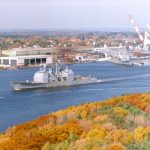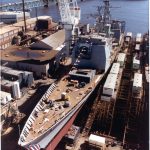As the FFG program wound down, the Navy was preparing for construction of the next large surface combatants, the Ticonderoga-class guided missile cruisers. The Ticonderogas were a version of the Spruance-class destroyers – the contract BIW had lost many years earlier – modified to carry the Aegis weapons system and radars.
Although all the Spruances had been built in a single shipyard, the Navy held a competition for a second yard to build the cruisers. BIW faced off against two other shipbuilders in a high-stakes competition, and in 1982 received a contract for the future Thomas S. Gates (CG 51). This was BIW’s largest warship in many years, and the contract pushed the yard’s backlog of work over $1 billion for the first time. The two competing shipyards were both out of business within a few years.
The keel for Thomas S. Gates was laid in August of 1984, and the ship was commissioned three years later. She was followed by seven more cruisers, with the last, Lake Erie, commissioned in 1993. Although Gates has been decommissioned, the later ships remain in service as a key component of today’s surface combatant fleet.
This period of steady work on larger, more complex warships allowed further process improvements and more investment in the shipyard. During this era BIW continued the trend towards pre-outfitted unit construction by introducing the “pre-outfit 2” construction stage, and construction of the PO2 building. In this phase, as is the case today, units were outfitted with insulation and finished equipment that could not be installed before the units were blasted and painted.
Another landmark arrived during this era, as the #15 crane was installed on the north side of A-ways. This 300-ton capacity crane, paired with the 220-ton #11 crane on the south side of B-ways, allowed dual-crane lifts of heavier pre-outfitted units onto ships under construction. The #15 crane was later moved to its current location when the Land Level Transfer Facility replaced the ways.
In 1985, even as the cruiser program moved forward, BIW again competed for a life-or-death contract, for the Arleigh Burke (DDG 51) class destroyers. The Burkes were intended as a modernized, less expensive version of the cruisers, packaging most of the same systems into a smaller hull. While BIW played a secondary role in the cruiser program, ultimately building 8 of 27 ships, the destroyer contract offered the opportunity for a lead-shipbuilder role and long-term stability for the yard.
Based in large part on its performance on the FFG program, BIW won the Arleigh Burke lead ship contract in 1985, securing the yard’s position as the Navy’s lead destroyer yard once again. Steel was cut for the first DDG in 1987, just as the first cruiser was delivered. At the time, no one realized the Burke class would become the longest-running shipbuilding program in history, continuing to 2016 and well beyond.



